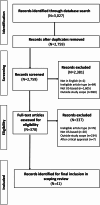Impact of hospital and health system initiatives to address Social Determinants of Health (SDOH) in the United States: a scoping review of the peer-reviewed literature
- PMID: 40045246
- PMCID: PMC11884203
- DOI: 10.1186/s12913-025-12494-2
Impact of hospital and health system initiatives to address Social Determinants of Health (SDOH) in the United States: a scoping review of the peer-reviewed literature
Abstract
Background: Hospital and health system initiatives addressing Social Determinants of Health (SDOH) are essential for achieving whole-person care and advancing health equity. Building on prior research characterizing these efforts (Part 1), this scoping review (Part 2) evaluates the effectiveness of these initiatives, with a focus on SDOH data integration, EHR utilization, and the broader scope of hospital efforts in addressing individual- and system-level determinants of health. Using an integrated conceptual framework combining the DeVoe & Cottrell framework for operational assessment and the National Academy of Medicine (NAM) 5A framework for systemic evaluation, this study provides a multidimensional assessment of hospital-based SDOH interventions.
Methods: Guided by PRISMA-ScR criteria, this review analyzed 41 U.S.-based studies published between 2018 and 2023, identified through three academic databases. Eligible studies examined hospital initiatives addressing SDOH with measurable outcomes. Analyses assessed SDOH data collection, integration into care practices, EHR use, and overall initiative effectiveness.
Results: Most studies (66%) were randomized controlled trials in urban settings (68%), targeting patients with chronic or mental health conditions (39%) or high-risk healthcare users (20%). Nearly half of initiatives (49%) addressed multiple SDOH domains, focusing on Social & Community Context, Economic Stability, and Neighborhood & Built Environment. Only 24% of initiatives utilized EHRs for SDOH data collection. EHR-based initiatives demonstrated significantly higher adherence to evidence-based practices, including use of community resource guides for referrals (90% vs. 45%, p = 0.013). Across all outcome measures, 79% demonstrated improvement, with no instances of worsening outcomes. However, 85% of initiatives lacked community-level SDOH data integration, and few employed upstream, universal strategies. Process, clinical, and social outcomes were unevenly prioritized, with only 10% of studies addressing all three outcome types.
Conclusions: While these initiatives reflect progress in integrating SDOH into care workflows and improving whole-person care at the individual level, progress toward health equity remains insufficient. Persistent gaps in EHR use, community-level data integration, and upstream strategies hinder systemic impact, potentially perpetuating disparities. Strengthening SDOH-EHR integration, fostering community partnerships, and supporting policy advocacy are critical to bridging individual and community needs. Future research should emphasize long-term, sustainable, and community-level impacts of hospital-led SDOH interventions.
Keywords: Electronic health records; Health equity; Health-related social needs; Hospitals and health systems; Population health; Quintuple aim; Social determinants of health; Whole person care.
© 2025. The Author(s).
Conflict of interest statement
Declarations. Ethics approval and consent to participate: Are not applicable to this scoping review of the literature. All methods were carried out in accordance with relevant guidelines and regulations. Consent for publication: Not applicable. Competing interests: The authors declare no competing interests.
Figures
Similar articles
-
Characteristics of hospital and health system initiatives to address social determinants of health in the United States: a scoping review of the peer-reviewed literature.Front Public Health. 2024 May 30;12:1413205. doi: 10.3389/fpubh.2024.1413205. eCollection 2024. Front Public Health. 2024. PMID: 38873294 Free PMC article.
-
Social determinants of health in electronic health records and their impact on analysis and risk prediction: A systematic review.J Am Med Inform Assoc. 2020 Nov 1;27(11):1764-1773. doi: 10.1093/jamia/ocaa143. J Am Med Inform Assoc. 2020. PMID: 33202021 Free PMC article.
-
The future of Cochrane Neonatal.Early Hum Dev. 2020 Nov;150:105191. doi: 10.1016/j.earlhumdev.2020.105191. Epub 2020 Sep 12. Early Hum Dev. 2020. PMID: 33036834
-
Beyond the black stump: rapid reviews of health research issues affecting regional, rural and remote Australia.Med J Aust. 2020 Dec;213 Suppl 11:S3-S32.e1. doi: 10.5694/mja2.50881. Med J Aust. 2020. PMID: 33314144
-
Preparing to Address Social Determinants of Health (SDOH): Approaches to Clinic Transformation.J Public Health Manag Pract. 2024 Jul-Aug 01;30:S39-S45. doi: 10.1097/PHH.0000000000001900. Epub 2024 Jun 12. J Public Health Manag Pract. 2024. PMID: 38870359
Cited by
-
Healthcare Continuity in Crisis: Addressing Gaps in Longitudinal Care Through Inferential Statistics.Cureus. 2025 Jul 16;17(7):e88127. doi: 10.7759/cureus.88127. eCollection 2025 Jul. Cureus. 2025. PMID: 40709022 Free PMC article.
-
Patient-level barriers, related facilitators, and proposed strategies for timely home health care and outpatient appointments for sepsis survivors: Perspectives from healthcare system and home health care informants.Patient Educ Couns. 2025 Sep;138:109207. doi: 10.1016/j.pec.2025.109207. Epub 2025 Jun 2. Patient Educ Couns. 2025. PMID: 40472764 Free PMC article.
References
-
- Solomon LS, Kanter MH. Health Care Steps Up to Social Determinants of Health: Current Context. Perm J. 2018;22:18–139. 10.7812/TPP/18-139. PMCID: PMC6207436.
-
- Hood CM, Gennuso KP, Swain GR, et al. County health rankings: relationships between determinant factors and health outcomes. Am J Prev Med. 2016;50(2):129–35. 10.1016/j.amepre.2015.08.024. - PubMed
Publication types
MeSH terms
LinkOut - more resources
Full Text Sources
Medical




